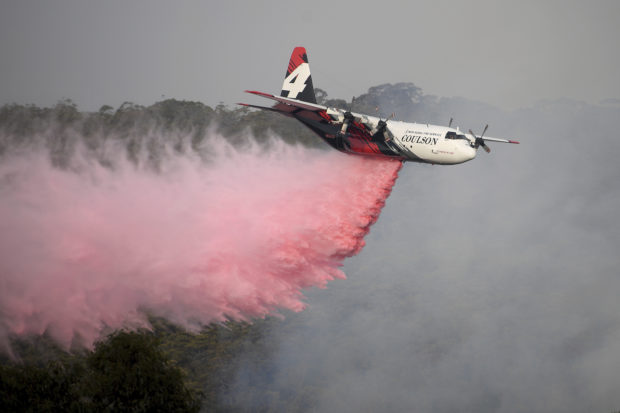
In this January 10, 2020, photo, Rural Fire Service large air tanker 134, operated by Coulson Aviation in the U.S. state of Oregon, drops fire retardant on a wildfire burning close to homes at Penrose, Australia, 165km south of Sydney. Three American crew members died Thursday when this C-130 Hercules aerial water tanker crashed while battling wildfires in southeastern Australia, officials said. (Dan Himbrechts/AAP Image via AP)
SYDNEY — The American tanker plane that crashed while fighting Australian wildfires had just dropped a load of retardant on a fire before it went down in New South Wales state, investigators said Friday.
The crash of the C-130 Hercules tanker Thursday killed Capt. Ian H. McBeth, 44, of Great Falls, Montana; First Officer Paul Clyde Hudson, 42, of Buckeye, Arizona; and Flight Engineer Rick A. DeMorgan Jr., 43, of Navarre, Florida, their employer, Canada-based Coulson Aviation, said in a statement.
The crash occurred during an unprecedented wildfire season that has left a large swath of destruction in Australia’s southeast.
Specialist investigators were sent to the crash site in the state’s Snowy Monaro region and a team was working to recover the victims’ bodies, Australian Transport Safety Bureau Chief Commissioner Greg Hood told reporters in the nearby town of Numeralla.
He described a difficult process of securing evidence of the crash and the victims’ remains, since the wildfire is still burning and potential hazards such as aviation fuel are present.
Upward of 500 firefighting aircraft from several countries are fighting Australia’s wildfires, Hood said, adding “So, if there are lessons to be learned from this particular accident it’s really important that not only Australia learns these, but the world learns them.”
He and other Australian officials extended condolences on the deaths of the three Americans.
Coulson Aviation said McBeth “was a highly qualified and respected C-130 pilot with many years fighting fire, both in the military and with Coulson Aviation.”
McBeth, who is survived by his wife and three children, also served with the Montana and Wyoming National Guard, the company said.
Hudson “graduated from the Naval Academy in 1999 and spent the next twenty years serving in the United States Marine Corp in a number of positions including C-130 pilot,” Coulson said. He is survived by his wife.
DeMorgan served in the U.S. Air Force with 18 years as a flight engineer on the C-130, the company said. He had had more than 4,000 hours as a flight engineer with nearly 2,000 hours in combat.
“Rick’s passion was always flying and his children,” Coulson said. He is survived by two children, his parents, and his sister.
New South Wales Premier Gladys Berejiklian said a memorial service would be held in Sydney on Feb. 23 for the American firefighters and three Australian volunteer firefighters who have died during this wildfire season.
“We will pay tribute to the brave firefighters who lost their own lives protecting the lives and properties of others,” she said.
“I know that many members of the public, the RFS (Rural Fire Service), and emergency services personnel will want to come together as families and communities work their way through this unbelievable loss.”
The three deaths bring Australia’s toll from the blazes to at least 31 since September. The fires have also destroyed more than 2,600 homes and razed more than 10.4 million hectares (25.7 million acres), an area bigger than the U.S. state of Indiana.
Coulson grounded other firefighting aircraft as a precaution pending investigation, reducing planes available to firefighters in New South Wales and neighboring Victoria state. The four-propeller Hercules drops more than 15,000 liters (4,000 gallons) of fire retardant in a single pass.
Berejiklian said more than 1,700 volunteers and personnel were in the field, and five fires were being described at an “emergency warning” level – the most dangerous on a three-tier scale – across the state and on the fringes of the national capital Canberra.